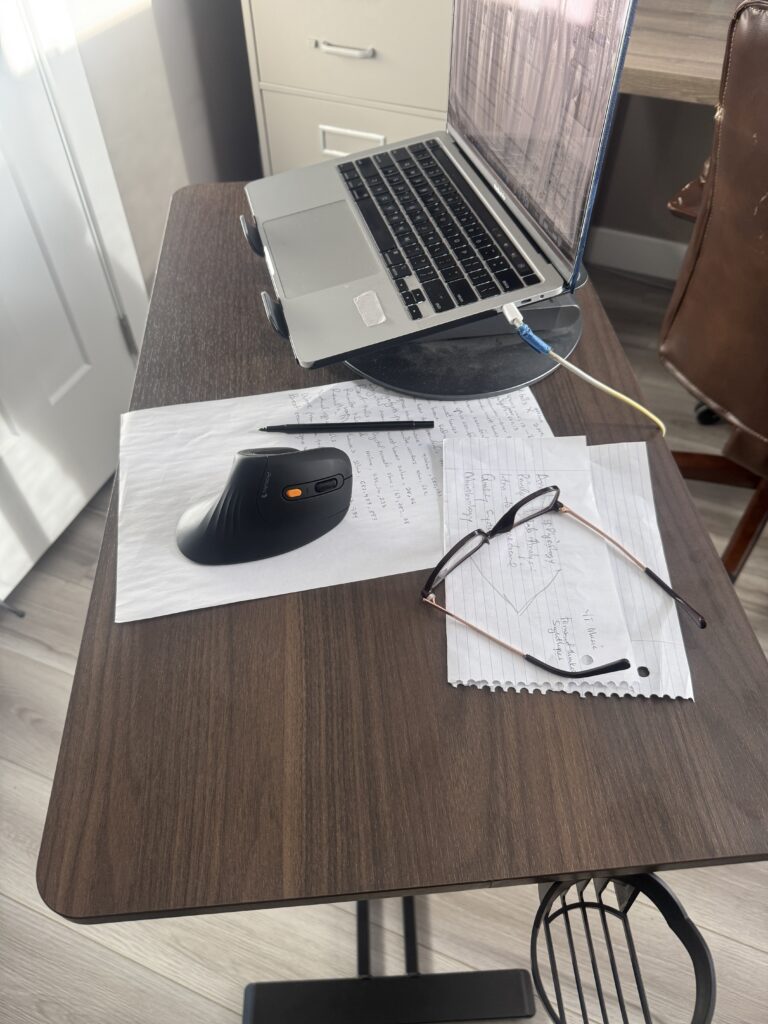As someone who’s worked both in an office environment and remotely, I know firsthand the toll that prolonged sitting can take on your body. Back pain from sitting all day affects millions of office workers, remote employees, and anyone tied to a chair for extended periods.
But with the right strategies and a bit of dedication, you can significantly reduce—or even eliminate—that nagging back pain.
Understanding the Sitting Predicament
Our bodies weren’t designed for prolonged sitting. When we sit for hours on end, our muscles become weak and tight, our posture suffers, and our spine bears uneven pressure.
This leads to that all-too-familiar ache in your lower back, stiffness in your shoulders, and tension headaches that can make your workday miserable.
By implementing a few key changes to your work routine and environment, you can improve your sitting experience into a comfortable, productive part of your day.
Ergonomics: Your First Line of Defense
The foundation of reducing back pain from sitting starts with proper ergonomics. Creating a workspace that supports your body’s natural alignment is crucial for long-term comfort and health.
Chair Adjustments: More Than Just Height
Your office chair is your most important ally in the fight against back pain. Here’s how to make it work for you:
- Height Adjustment: Set the chair height so your feet are flat on the floor and your knees are at a 90-degree angle.
This position promotes proper blood flow and reduces pressure on your lower back.
- Lumbar Support: Adjust the lumbar support to fit the curve of your lower back.
This helps maintain the natural S-curve of your spine, preventing slouching and reducing strain on your back muscles.
- Seat Depth: Ensure the seat depth allows for a fist-sized gap between the edge of the seat and the back of your knees.
This prevents pressure on the back of your thighs and promotes better circulation.
- Armrest Position: Set the armrests so your shoulders are relaxed and your elbows are at a 90-degree angle.
This reduces strain on your neck and shoulders.
- Backrest Angle: Adjust the backrest to support your spine in a slightly reclined position (100-110 degrees).
This angle reduces pressure on your intervertebral discs.
Monitor Positioning: Eye Level is Key
Proper watch placement prevents neck strain, which often leads to upper back pain. Follow these guidelines:
- Position your screen at eye level.
The top of the screen should be at or slightly below eye level.
- Place the watch about an arm’s length away from your seated position.
- If you’re using a laptop, consider investing in a separate keyboard and mouse to achieve this setup.
A laptop stand can elevate your screen to the proper height.
- For dual watches, position them side by side with no gap, centering the one you use most often directly in front of you.
Keyboard and Mouse Placement: Wrist Wellness
Proper positioning of your keyboard and mouse is crucial for preventing strain in your wrists, arms, and shoulders:
- Keep your keyboard and mouse close to your body to avoid reaching, which can strain your shoulders and upper back.
- Position your keyboard so your wrists are in a neutral position, not bent up or down.
Consider using a keyboard tray that allows for negative tilt.
- Use a mouse that fits comfortably in your hand.
A vertical mouse can help maintain a more natural wrist position.
- Consider using keyboard shortcuts to reduce mouse usage and minimize repetitive movements.
The Power of Movement
While ergonomics is crucial, movement is the hidden weapon in your arsenal against back pain. Incorporating regular movement into your workday can significantly reduce muscle tension, improve circulation, and prevent the stiffness associated with prolonged sitting.
Microbreaks: Small Moves, Big Impact
Taking short, frequent breaks throughout your workday can make a world of difference in managing back pain:
- Set a timer to remind you to take a short break every 30 minutes.
- Stand up, stretch, or take a quick walk around your office during these breaks.
- Use the 20-20-20 rule: Every 20 minutes, look at something 20 feet away for 20 seconds.
This helps reduce eye strain and encourages small movements.
- Consider using a sit-stand desk to alternate between sitting and standing throughout the day.
Desk Exercises: Stealth Stretching
You don’t need a gym to keep your muscles limber. Try these discreet exercises at your desk:
- Shoulder rolls: Slowly roll your shoulders backwards and forwards 10 times each.
This helps release tension in your upper back and neck.
- Seated spinal twist: Gently twist your torso to each side, holding for 10-15 seconds.
This improves spinal mobility and stretches your back muscles.
- Neck stretches: Slowly tilt your head from side to side, holding for 10 seconds on each side.
Then, gently lower your chin to your chest and hold for 10 seconds.
This relieves tension in your neck and upper shoulders.
- Ankle rotations: Circle your ankles 10 times in each direction to improve lower body circulation and prevent swelling in your feet and legs.
- Seated leg raises: Straighten one leg and hold it up for 10 seconds, then lower it back down.
Repeat with the other leg.
This engages your core and improves circulation in your legs.
- Wrist and finger stretches: Extend your arms in front of you and gently pull your fingers back towards your body with your other hand.
Hold for 10 seconds, then shake out your hands.
This helps prevent carpal tunnel syndrome and relieves wrist tension.

The Standing Revolution
Standing desks have gained popularity for good reason. Alternating between sitting and standing throughout the day can reduce back pain and increase energy levels.
Here’s how to incorporate standing into your work routine:
- Start slowly: Begin with 15-30 minutes of standing per hour and gradually increase as your body adjusts.
- Use an anti-fatigue mat to reduce pressure on your feet and legs when standing.
- Maintain proper posture while standing: keep your shoulders back, engage your core, and avoid locking your knees.
- If a full standing desk isn’t an option, consider a desk converter that sits on top of your existing workspace.
- Use a high stool or perching seat for times when you need a break from full standing but don’t want to fully sit.
Strengthening Your Core: The Back’s Best Friend
A strong core acts as your body’s natural corset, providing support for your spine and improving posture. Incorporating these exercises into your routine can significantly reduce back pain:
- Planks: Start with 15-second holds and gradually increase.
Focus on maintaining a straight line from your head to your heels, engaging your core throughout.
- Bird dogs: Begin on all fours.
Extend your right arm forward while extending your left leg back.
Hold for 5-10 seconds, then switch sides. This exercise improves balance and strengthens your lower back.
- Bridges: Lie on your back with your knees bent and feet flat on the floor.
Lift your hips towards the ceiling, squeezing your glutes at the top.
Hold for 5 seconds, then lower back down. Repeat 10-15 times.
- Cat-cow stretch: Start on all fours.
Inhale as you arch your back and look up (cow pose), then exhale as you round your spine and tuck your chin to your chest (cat pose).
Repeat 10-15 times to improve spinal flexibility.
- Superman: Lie face down with your arms extended in front of you.
Simultaneously lift your arms, legs, and chest off the ground.
Hold for 5 seconds, then lower back down. Repeat 10-15 times to strengthen your lower back muscles.
Aim to do these exercises for 5-10 minutes daily, either during your lunch break or after work. Consistency is pivotal in building core strength and reducing back pain.
Mindful Sitting: Awareness is Half the Battle
Often, we slouch or contort ourselves without realizing it. Practicing mindful sitting can help maintain good posture throughout the day:
- Set reminders to check your posture every hour.
Use sticky notes, phone alerts, or desktop notifications.
- Practice the “sit bones rock” – gently rock forward and back on your sit bones to find your natural spine alignment.
This helps you become more aware of your seated position.
- Here’s a string pulling the top of your head towards the ceiling to elongate your spine.
This mental image can help you maintain proper alignment throughout the day.
- Use the “chin tuck” exercise: Gently draw your chin back, creating a “double chin.” Hold for 5 seconds, then release.
This strengthens the deep neck flexors and improves posture.
- Focus on your breath: Take deep, diaphragmatic breaths throughout the day.
This reduces stress and encourages better posture and core engagement.
Beyond the Office: Lifestyle Factors
Reducing back pain isn’t limited to what you do at work. Consider these lifestyle adjustments to support your back health:
Sleep Posture: Nighttime Support
Your sleeping position and bedding can significantly impact your back health:
- Invest in a supportive mattress that maintains proper spinal alignment.
Medium-firm mattresses often provide the best support for back pain sufferers.
- Use a pillow that keeps your neck aligned with your spine.
Side sleepers may need a thicker pillow, while back sleepers often benefit from a thinner one.
- If you sleep on your side, place a pillow between your knees to keep your hips aligned.
- Back sleepers can place a small pillow under their knees to reduce pressure on the lower back.
- Avoid sleeping on your stomach, as this position can strain your neck and lower back.
Hydration: Fluid Support for Your Spine
Proper hydration keeps your spinal discs healthy and functioning optimally:
- Aim to drink at least 8 glasses of water per day.
Your spinal discs are mostly water, and staying hydrated helps maintain their shock-absorbing properties.
- Consider keeping a water bottle at your desk and setting reminders to drink regularly throughout the day.
- Eat water-rich foods like cucumbers, watermelon, and zucchini to supplement your fluid intake.
- Limit caffeine and alcohol consumption, as these can contribute to dehydration.
Stress Management: Relaxing Your Back
Stress can cause muscle tension, exacerbating back pain. Try these stress-reduction techniques:
- Practice deep breathing exercises: Take slow, deep breaths, focusing on expanding your belly as you inhale and relaxing as you exhale.
- Try progressive muscle relaxation: Systematically tense and relax different muscle groups, starting from your toes and working up to your head.
- Incorporate mindfulness meditation into your daily routine.
Even 5-10 minutes a day can make a significant difference in reducing stress and muscle tension.
- Consider yoga or tai chi classes, which mix movement, breathing, and mindfulness to reduce stress and improve flexibility.
- Engage in hobbies or activities you enjoy outside of work to help manage stress levels.
The Tech Solution: Apps and Gadgets
In our digital age, there are plenty of tech solutions to help you maintain good posture and reduce back pain:
Posture Apps
These use your device’s camera to analyze and fix your posture in real-time:
- PostureScreen Mobile: This app takes photos of your posture from different angles and provides a detailed analysis and improvement plan.
- Lumo Lift: A small sensor that attaches to your clothing and vibrates when you slouch, reminding you to straighten up.
- PosturePal: Uses your phone’s accelerometer to detect poor posture and alerts you to fix it.
Wearable Posture Devices
Small sensors that attach to your back or clip onto your clothes to vibrate when you slouch:
- Upright GO 2: A small device that sticks to your upper back and gently vibrates when you slouch, training you to maintain better posture over time.
- Backbone: A posture corrector that wraps around your shoulders and upper back, providing gentle resistance to encourage proper alignment.
- Zikto Walk: A wearable device that analyzes your walking pattern and posture, providing feedback to improve your gait and reduce back strain.
Smart Chairs
These high-tech seats adjust automatically to support your posture throughout the day:
- Herman Miller Embody: Uses a flexible spine and dynamic support to encourage movement and proper alignment.
- Steelcase Gesture: Adjusts to your body as you move, supporting a wide range of postures and work styles.
- FelixKing Ergonomic Desk Chair: Features many adjustment points and a self-adjusting mechanism to support your spine throughout the day.
When to Seek Professional Help
While these strategies can significantly reduce back pain for many people, persistent or severe pain may require professional intervention. Consider consulting a healthcare professional if:
- Your back pain persists for more than a few weeks despite implementing these changes.
- You experience severe pain, numbness, or tingling in your legs.
- Your pain is accompanied by unexplained weight loss, fever, or changes in bowel or bladder function.
- The pain is the result of a fall or injury.
- Your pain is worse at night or interferes with your sleep.
A physical therapist, chiropractor, or orthopedic specialist can provide personalized treatment plans, which may include:
- Targeted exercises and stretches to address your specific pain points.
- Manual therapy techniques to improve mobility and reduce pain.
- Ergonomic assessments of your workspace to identify and fix issues.
- Education on proper body mechanics for daily activities.
- In some cases, they may recommend extra treatments such as acupuncture, massage therapy, or even minimally invasive procedures for severe cases.
Early intervention can prevent chronic issues and lead to faster recovery.
People Also Asked
How long does it take to see improvements in back pain from better posture?
Many people notice some relief within a few days to a week of consistently practicing good posture. However, significant improvements typically take 2-4 weeks of consistent effort.
Can standing desks cause back pain?
While standing desks can help reduce back pain for many people, improper use can cause discomfort. It’s important to gradually increase standing time and maintain proper posture while using a standing desk.
What are the best exercises for lower back pain from sitting?
Some effective exercises include cat-cow stretches, pelvic tilts, bridges, and gentle twists. Always talk to a healthcare professional before starting a new exercise routine, especially if you have existing back pain.
How often should I take breaks from sitting?
Aim to take a short break every 30-60 minutes. Even standing up for a minute or two can help reduce the negative effects of prolonged sitting.
Are ergonomic chairs worth the investment?
For many people, a high-quality ergonomic chair can significantly reduce back pain and improve overall comfort. However, it’s important to choose a chair that fits your body and to adjust it properly.
Can poor posture cause permanent damage?
While poor posture over time can lead to chronic pain and muscle imbalances, these issues are often reversible with proper treatment and consistent good posture habits.
What’s the best sleeping position for back pain?
Sleeping on your back with a pillow under your knees or on your side with a pillow between your knees often provides the best support for your spine.
How does weight affect back pain from sitting?
Excess weight, especially around the midsection, can increase strain on the lower back. Maintaining a healthy weight through diet and exercise can help reduce back pain.
Can stress cause back pain even with good posture?
Yes, stress can cause muscle tension and exacerbate back pain, even if you maintain good posture. Stress management techniques can help reduce this type of pain.
Are there any specific foods that can help reduce back pain?
Anti-inflammatory foods like fatty fish, leafy greens, and berries may help reduce inflammation associated with back pain. Staying hydrated is also crucial for spinal health.
Key Takeaways
- Proper ergonomics is the foundation of a back-friendly workspace.
Adjust your chair, watch, keyboard, and mouse for optimal alignment.
- Regular movement and stretching throughout the day are crucial.
Take microbreaks and perform desk exercises to keep your muscles limber.
- Strengthening your core provides essential support for your back.
Incorporate exercises like planks, bird dogs, and bridges into your routine.
- Mindful sitting and posture awareness can prevent unconscious slouching.
Set reminders and practice techniques to maintain good posture throughout the day.
- Lifestyle factors like sleep, hydration, and stress management play a significant role in back health.
Address these areas to support overall spine health.
- Technology can be a helpful tool in maintaining good posture and reducing back pain. Consider using posture apps, wearable devices, or smart chairs.
- Consistent application of these strategies can lead to significant improvements in back pain from sitting.
However, persistent or severe pain may require professional intervention.





